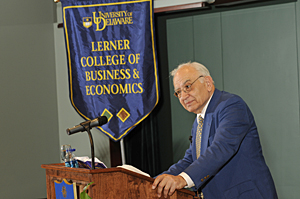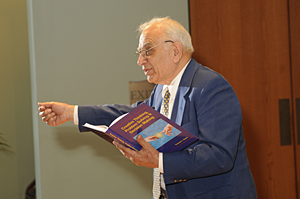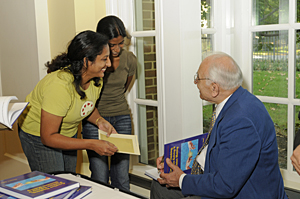

- Rozovsky wins prestigious NSF Early Career Award
- UD students meet alumni, experience 'closing bell' at NYSE
- Newark Police seek assistance in identifying suspects in robbery
- Rivlin says bipartisan budget action, stronger budget rules key to reversing debt
- Stink bugs shouldn't pose problem until late summer
- Gao to honor Placido Domingo in Washington performance
- Adopt-A-Highway project keeps Lewes road clean
- WVUD's Radiothon fundraiser runs April 1-10
- W.D. Snodgrass Symposium to honor Pulitzer winner
- New guide helps cancer patients manage symptoms
- UD in the News, March 25, 2011
- For the Record, March 25, 2011
- Public opinion expert discusses world views of U.S. in Global Agenda series
- Congressional delegation, dean laud Center for Community Research and Service program
- Center for Political Communication sets symposium on politics, entertainment
- Students work to raise funds, awareness of domestic violence
- Equestrian team wins regional championship in Western riding
- Markell, Harker stress importance of agriculture to Delaware's economy
- Carol A. Ammon MBA Case Competition winners announced
- Prof presents blood-clotting studies at Gordon Research Conference
- Sexual Assault Awareness Month events, programs announced
- Stay connected with Sea Grant, CEOE e-newsletter
- A message to UD regarding the tragedy in Japan
- More News >>
- March 31-May 14: REP stages Neil Simon's 'The Good Doctor'
- April 2: Newark plans annual 'wine and dine'
- April 5: Expert perspective on U.S. health care
- April 5: Comedian Ace Guillen to visit Scrounge
- April 6, May 4: School of Nursing sponsors research lecture series
- April 6-May 4: Confucius Institute presents Chinese Film Series on Wednesdays
- April 6: IPCC's Pachauri to discuss sustainable development in DENIN Dialogue Series
- April 7: 'WVUDstock' radiothon concert announced
- April 8: English Language Institute presents 'Arts in Translation'
- April 9: Green and Healthy Living Expo planned at The Bob
- April 9: Center for Political Communication to host Onion editor
- April 10: Alumni Easter Egg-stravaganza planned
- April 11: CDS session to focus on visual assistive technologies
- April 12: T.J. Stiles to speak at UDLA annual dinner
- April 15, 16: Annual UD push lawnmower tune-up scheduled
- April 15, 16: Master Players series presents iMusic 4, China Magpie
- April 15, 16: Delaware Symphony, UD chorus to perform Mahler work
- April 18: Former NFL Coach Bill Cowher featured in UD Speaks
- April 21-24: Sesame Street Live brings Elmo and friends to The Bob
- April 30: Save the date for Ag Day 2011 at UD
- April 30: Symposium to consider 'Frontiers at the Chemistry-Biology Interface'
- April 30-May 1: Relay for Life set at Delaware Field House
- May 4: Delaware Membrane Protein Symposium announced
- May 5: Northwestern University's Leon Keer to deliver Kerr lecture
- May 7: Women's volleyball team to host second annual Spring Fling
- Through May 3: SPPA announces speakers for 10th annual lecture series
- Through May 4: Global Agenda sees U.S. through others' eyes; World Bank president to speak
- Through May 4: 'Research on Race, Ethnicity, Culture' topic of series
- Through May 9: Black American Studies announces lecture series
- Through May 11: 'Challenges in Jewish Culture' lecture series announced
- Through May 11: Area Studies research featured in speaker series
- Through June 5: 'Andy Warhol: Behind the Camera' on view in Old College Gallery
- Through July 15: 'Bodyscapes' on view at Mechanical Hall Gallery
- More What's Happening >>
- UD calendar >>
- Middle States evaluation team on campus April 5
- Phipps named HR Liaison of the Quarter
- Senior wins iPad for participating in assessment study
- April 19: Procurement Services schedules information sessions
- UD Bookstore announces spring break hours
- HealthyU Wellness Program encourages employees to 'Step into Spring'
- April 8-29: Faculty roundtable series considers student engagement
- GRE is changing; learn more at April 15 info session
- April 30: UD Evening with Blue Rocks set for employees
- Morris Library to be open 24/7 during final exams
- More Campus FYI >>
4:49 p.m., Oct. 13, 2008----Thomas L. Saaty, University Chaired Professor and professor of business administration in the Joseph M. Katz Graduate School of Business at the University of Pittsburgh, addressed the two anchors of success--creativity and “stick-to-it-iveness”--at the first Chaplin Tyler Executive Leadership Lecture of 2008, held Friday afternoon, Oct. 10, at the Louise and David Roselle Center for the Arts
Speaking to an audience of approximately 120 UD students, faculty administrators and guests from the community, Saaty, whose lecture was titled, “Motivating Creativity and Problem Solving,” highlighted examples of how unconventional thinking could short-circuit brainfreeze and leapfrog stumbling blocks, and dotted his lecture with jokes, anecdotes and YouTube clips that illustrated his points with humor.
After introductory remarks by UD President Patrick Harker and Conrado (Bobby) M. Gempesaw, dean of the Lerner College of Business and Economics, Saaty opened his lecture with the theme music to the film 2001: A Space Odyssey and a slide listing six different kinds of challenges encountered by individuals on a daily basis, including physical, environmental and cognitive limitations.
He then made the point that “the greatest challenge--and risk--of all is not to take one,” and emphasized that “creativity is the actualization of an individual's potential.
“Creativity involves originality, novelty and risk-taking,” Saaty said, “and the question is not so much whether we are smart enough for a challenge, but whether or not we persevere.”
Enforcing this point with well-known examples of “late bloomers” and “incorrigible” students who met with success later in life (Albert Einstein, Thomas Edison and Carl Jung, to name just a few), Saaty said that many factors--not all of them readily evident--contributed to an individual's overall brilliance, and added that personal happiness also played a critical role.
“Everybody is born a genius, but living de-geniuses them,” Saaty quipped, “and only by maintaining the ability to care and remain open-hearted can you keep the spirit of a generous, creative person.”
Saaty talked about conflicting theories and “evidence” linking creativity with intelligence and said that while some well-regarded psychologists claimed to have found a link between the two in individuals with intelligence quotients of 130 and above, the evidence is inconclusive, and no such link has been proven to exist in individuals with intelligence quotients of 120 and below--the vast majority of the world's population.
“Very intelligent people may not be at all creative,” Saaty said, “and likewise, very creative people may not be all that 'intelligent.' Beethoven, for instance, could not to his dying day be taught to do fractions; and there are many different kinds of intelligence.”
Saaty went on to stress the important role persistence plays in any successful endeavor and made the point that while innovative people might have restless curiosity, an eagerness to work diligently is critical compared to high levels of creativity.
“Everyone has the ability to do great things when they have a goal to pursue,” Saaty said, “but the critical reality is that creativity and expertise take time and nurturing and training.”
Saaty spent the later part of his one-and-a-half-hour lecture involving the audience in creative problem-solving activities, including rebus puzzles, “shaggy dog” stories and an extensive exercise in getting an elephant (hypothetically, of course) into the Gore Recital Hall.
His lecture was followed by a reception in the lobby of the Louise and David Roselle Center for the Arts, where he was joined by his wife, Rozann; his daughter, Emily Harker; his son-in-law, Patrick Harker; and his grandchildren, all of whom also attended his lecture.
Saaty is the architect of Analytic Hierarchy Process (AHP) decision theory and its generalization to decisions with dependence and feedback--the Analytic Network Process (ANP)--for which he received the gold medal from the International Society for Multicriteria Decisions.
He has written numerous articles and more than 12 books on these subjects, and his nontechnical book on AHP, Decision Making for Leaders, has been translated into more than 10 languages. Another book, The Brain: Unraveling the Mystery of How it Works, takes ANP further to neural firing and synthesis.
Before joining the University of Pittsburgh, Saaty was a professor at the Wharton School of Business at the University of Pennsylvania, and before that was with the Arms Control and Disarmament Agency at the U.S. State Department. He is a member of the National Academy of Engineering and serves on the board of advisers to Decisions Lens, a company based on his AHP and ANP processes.
Saaty is a graduate of Columbia Union College and has a master's degree in physics from the Catholic University of America, as well as master's and doctoral degrees in mathematics from Yale University.
The Chaplin Tyler Executive Leadership Lecture Series, presented by UD's Alfred Lerner College of Business and Economics, each year brings leaders from business, nonprofit organizations and the government to campus to share their experiences and insights with students, faculty and the business community in an open exchange of ideas and perspectives.
The series is supported by the Chaplin Tyler Endowment Fund and is dedicated to the memory of the late Chap and Elizabeth Tyler and their commitment to education and helping young people achieve success in the business world.
Article by Becca Hutchinson
Photos by Duane Perry



